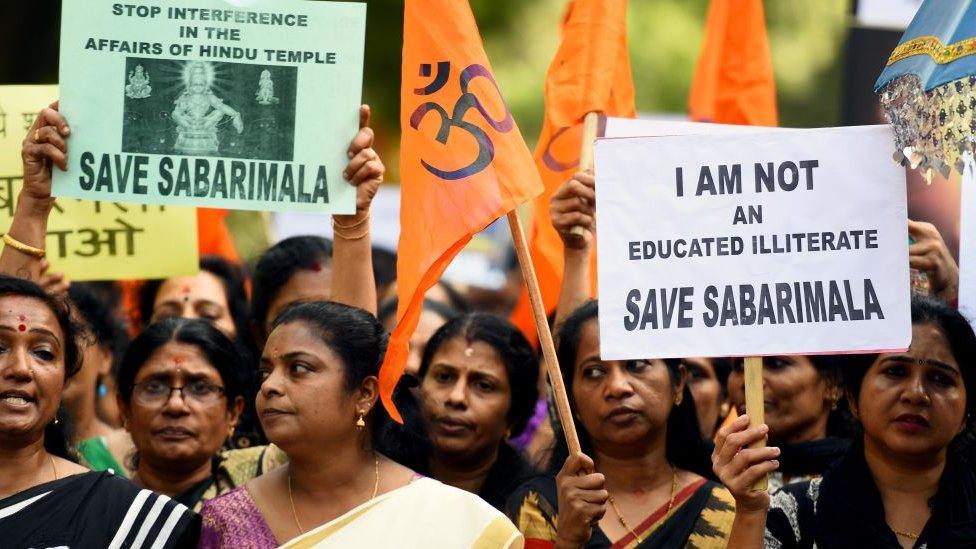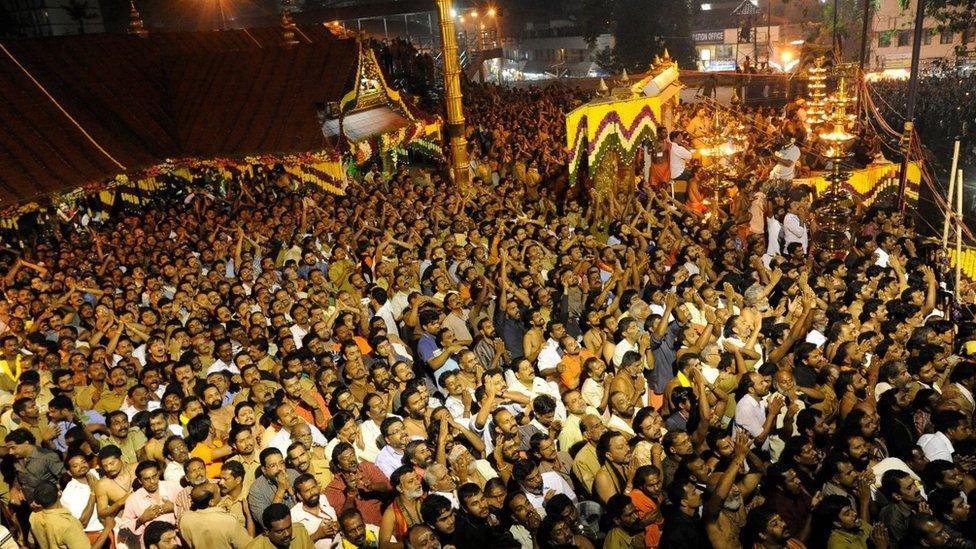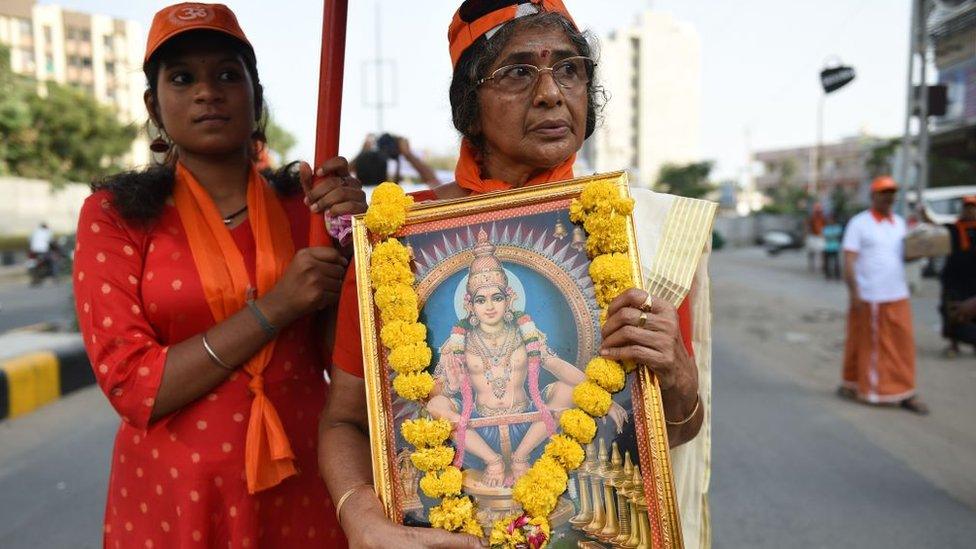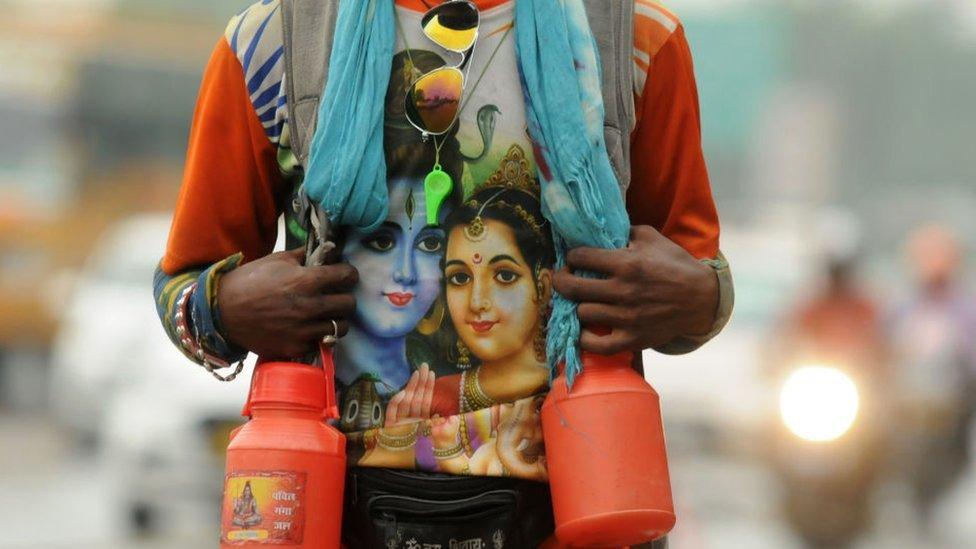Viewpoint: The 'feminist' ruling angering Indian women
- Published

Protesting women feel that no one cares to understand their worldview
A recent Supreme Court ruling, which has been hailed as a feminist victory, has instead angered the Indian women it was meant to empower, says commentator Shyam Krishnakumar.
At the Sabarimala temple in the southern Indian state of Kerala, a tense stand-off is under way between women who are determined to use a judicial verdict to enter the temple and large groups of devotees including women, making a last-ditch effort to preserve the integrity of their age-old traditions.
The issue began with a recent Supreme Court verdict allowing the entry of women between the ages of 10 and 50, which was prohibited by the temple's traditions.
Why has a seemingly feminist verdict caused a groundswell of protest including from the very subaltern women it was meant to empower?
Sabarimala commands a massive following cutting across caste, gender and linguistic lines. Every year, millions of pilgrims including tribal communities, Muslims and Christians, undertake a rigorous 41-day fast and embark on a barefoot pilgrimage to the temple which located in the dense forests of the Western Ghats.

Sabarimala is dedicated to the deity Ayyappa in the form of an eternal celibate in penance
The temple is dedicated to the deity Ayappa in the form of an eternal celibate in penance. Therefore, traditionally only men, very young girls or post-menopausal women enter the temple.
Two weeks ago, a five judge bench of India's Supreme Court struck down the restriction on women of "menstruating ages". The four male judges delivered a majority verdict on the grounds of gender discrimination and because it wasn't an "essential practice" of the denomination.
Indu Malhotra, the only woman judge on the bench, disagreed with the majority verdict.
"Issues of deep religious sentiments should not be ordinarily interfered by the court... Notions of rationality cannot be invoked in matters of religion," she said in her dissenting opinion.
Observing that women's right to worship Lord Ayappa was not violated as there are a thousand other Ayappa temples without restrictions on women. Justice Malhotra added the court must not interfere unless approached by an aggrieved person from the denomination.
Objections notwithstanding, the verdict was widely celebrated as a progressive step by an activist judiciary in ensuring women's "right of worship".

Many of the protesters against women entering the temple are women themselves
Then, something unexpected happened.
In town after town in Kerala, tens of thousands of women hit the streets protesting against the verdict. This spread across India with marches in Delhi, Bangalore, Chennai and internationally in the UK, US and Canada.
Sensing the pulse, India's leading Hindu nationalist organisation, the Rashtriya Swayamsevak Sangh (RSS), and the ruling Bharatiya Janta Party (BJP), who were initially in favour of the judgement, did a flip-flop and were eager to be seen supporting the protests.
The main opposition Congress party also joined the bandwagon. Consequently, multiple party-led protest marches and some incendiary statements followed.
Imposing a liberation
Kerala is not a place where women are voiceless. It has historically been a matrilineal society where women have controlled and inherited property for centuries. The state has the highest literacy rate in India and its social indicators are comparable to developed countries.
The protesting women feel that no one cared to understand their worldview. They feel that those with privilege and a voice are imposing a "liberation" that these women do not seek.
"The authorities misread the situation by looking at this issue through a colonial prism," says Anjali George, who pioneered a social media campaign in favour of the temple's ban on women.
"This has effectively contributed to a situation where people are losing faith in the ability of the system to protect their religious rights and traditions."

Hinduism comprises a diverse set of cultural practices and traditions
Hinduism is an umbrella term for a staggeringly diverse set of cultural practices, traditions and systems of worship.
While the celibate Lord Ayappa at Sabarimala does not see women devotees of a certain age, the same deity is worshipped in a married form in other temples by both women and men.
And it's not only women who are barred from some temples.
The Kamakhya Temple in the northeastern state of Assam bars men from entering during the auspicious time when the goddess menstruates.
Creating artificial homogeneity
Hardly a dozen among the few millions of temples in India have gender-based entry restrictions. Equality cannot become a premise to create an artificial homogeneity, forcing a conformity that destroys diverse, intergenerational practices which enjoy the support of all stakeholders including women.
No efforts are taken to sincerely engage with the practices of the actual stakeholders. What masquerades under the garb of "reform" is a way to impose modernity on native practices by judicial writ and state force if necessary.
The judgement has also raised disturbing questions about the relationship between religion and state in India.
The government has become increasingly involved in managing religious institutions and the judiciary in determining correct religious practice. Noted advocates Fali Nariman and Rajeev Dhavan offer a scathing indictment of this saying "judges have virtually assumed the theological authority to determine which tenets of a faith are 'essential'".
The stand-off at Sabarimala exposes the stark dichotomy between a cosmopolitan elite who celebrate the "liberation" of women and the visceral grassroots reaction from millions of women devotees who feel their voices are not being heard in today's India.
- Published19 October 2018

- Published9 August 2018
